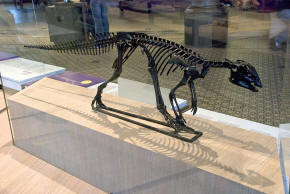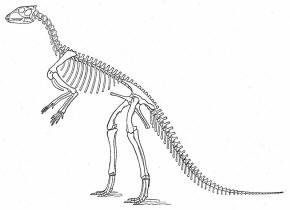on the
Isle of Wight, off the
south coast of England. Other finds have been made in southern England and
Portugal.
Another misconception concerning the
anatomy of Hypsilophodon
was that it was armoured. The putative armour, consisting of thin
mineralized plates from the torso, instead appear to be examples of
intercostal plates associated with the rib cage. Such plates are better
known from
Talenkauen and
Thescelosaurus, and
were probably
cartilaginous in
origin.
There is only one known species of
Hypsilophodon,
Huxley's original H. foxii.
Galton and Jensen named another species in 1979,
H. wielandi, which is
based on a thigh bone from South Dakota, USA, but it is now regarded as an
indeterminate
basal ornithopod.
Paleobiology
Hypsilophodon
was a relatively small dinosaur. While not quite so small as, for example,
Compsognathus,
Hypsilophodon was only
around 2.3 metres in length. It would have reached approximately
waist-height on a modern man and would have weighed about the same, at 50 to
70 kilograms (110 to 150 lb).
Like most small dinosaurs,
Hypsilophodon was bipedal
and ran on two legs. Its entire body was built for running; a light-weight,
minimized skeleton, low, aerodynamic posture, long legs and stiff tail for
balance all would have allowed it to travel remarkably fast for its size.
Due to its small size,
Hypsilophodon fed on
low-growing vegetation, most likely preferring young shoots and roots in the
manner of modern deer. The structure of its skull, with the teeth set far
back into the jaw, strongly suggests that it had cheeks, an advanced feature
that would have facilitated the chewing of food. There were twenty-eight to
thirty ridged teeth in the animal's jaw which, due to their alternate
arrangement, appear to have been self-sharpening. As in almost all dinosaurs
and certainly all the ornithischians, the teeth were continuously replaced.
The level of parental care in this
dinosaur has not been defined, although a neatly-arranged nest has been
found, suggesting that some care was taken before hatching. Fossils of large
groups have been found, so it is likely that the animals moved in herds. For
these reasons, the
hypsilophodonts,
particularly Hypsilophodon,
have often been referred to as the "deer of the Mesozoic".
Despite living in the last of the
periods in which dinosaurs walked the earth, the Cretaceous,
Hypsilophodon had a number
of primitive features. For example, there were five
digits on each 'hand'
and four on each foot. Most dinosaurs had lost these redundant features by
the Cretaceous period. Also, although it had a beak like most
ornithischians, Hypsilophodon
still had pointed triangular teeth in the front of the jaw. Most herbivorous
dinosaurs had, by this stage, become sufficiently specialized that the front
teeth had been altogether lost (although there is some debate as to whether
these teeth may have had a specialized function in
Hypsilophodon).
The group Hypsilophodontidae
remained remarkably static from the late Jurassic to the end of the
Cretaceous. It is possible that this was because the animals were almost
perfectly adapted to their lifestyle, therefore selective pressure, it is
assumed, was low.
Return to the
Old Earth Ministries Online Dinosaur
Curriculum homepage.


